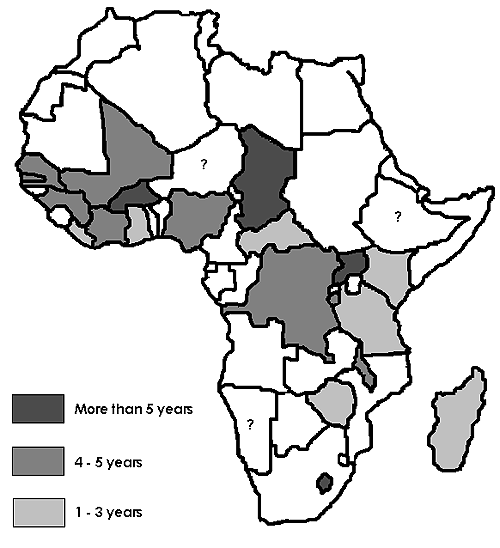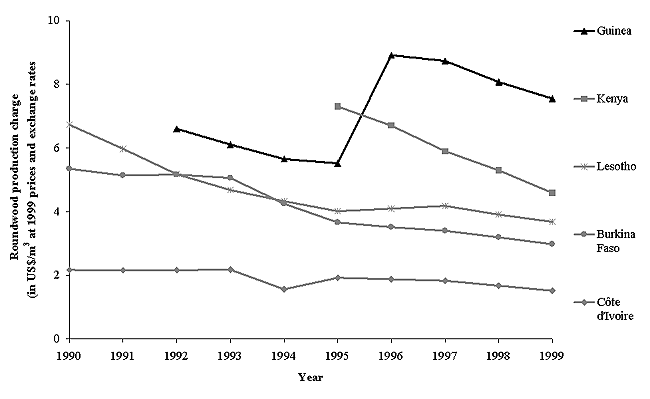


TRENDS IN FOREST CHARGES
In a few countries in Africa, forest charges are determined by market mechanisms or procedures based on market prices. However, in the majority of cases, forest charges are fixed using an administrative procedure (e.g. Ministerial Decree or Regulation). In the latter case, it is often difficult to revise forest charges regularly either because of the time that it takes to consider, agree and implement a new regulation or because external forces (e.g. the forest industry) attempt to slow down or stop the revision of forest charges.

Figure 6 The number of countries reviewing or revising their forest
charges over different time periods
Figure 6 shows how regularly countries have revised their forest charges in recent years. This figure is based mainly on the revision of roundwood production charges. In some countries, if the revision of other charges (e.g. charges for NWFPs) is taken into account, then revisions have been more frequent. In addition, in some countries, forest charges are not revised very often, but new charges have been introduced in recent years. Where possible, these have been taken into account in this figure.
As the figure shows, a few countries revise their charges quite regularly (e.g. every one or two years). These tend to be the countries where forest charges are set using market mechanisms or are based on market prices in some way (e.g. Kenya, Madagascar, Zimbabwe). The majority of countries have revised their charges less frequently, with most countries revising their charges every three to five years on average. In a small minority of countries, forest charges have been revised very rarely. The average time between reviews of forest charges is also shown in Figure 7.
In countries where inflation is quite high, the effect of infrequent revisions of forest charges is that the real level of forest charges falls over time as the fixed amounts specified in schedules of forest charges are eroded by inflation. Furthermore, when charges are revised, large increases are often required to compensate for these losses.

Figure 7 The average number of years between reviews of forest charges
Information about trends in forest charges over the last ten years was available for 11 countries and is presented here. The rate of inflation in these countries has been quite high, between 4 percent and 10 percent per year in most countries. One exception is Liberia, which has had a relatively low level of inflation (an average of 2.7 percent over the period 1990 to 1999) due to the widespread use of the US$ in this country. On the other hand, the average rates of inflation in Ghana, Kenya and Nigeria over the last ten years have been much higher, at 25 percent, 15 percent and nearly 40 percent respectively.
Figure 8 Indicative trends in roundwood production charges from 1990 to 1999 in Guinea, Kenya, Lesotho, Burkina Faso and Côte d’Ivoire (in US$ per cubic metre at 1999 prices and exchange rates)

Figure 8 shows trends in roundwood production charges over the last ten years in a number of countries where roundwood production charges are less than US$ 10 per cubic metre. For each country, these figures present the average level of roundwood production charges for the main species groups used for industrial roundwood production in the country. They have been adjusted for inflation by dividing the charge levels in each year by the GDP deflator for each country and then they have been converted to US$ using the market exchange rate in 1999.
It should be noted that, in a number of cases, the total amount of charges collected from industrial roundwood production is higher than the figures shown here, because additional charges are also collected in the form of area-based charges or charges on international trade (e.g. in Côte d’Ivoire). However, in most cases, the trends in these other charges are more or less the same as the trends shown here.
The effect of inflation on the real level of forest charges is shown most clearly in Lesotho and Burkina Faso, neither of which have revised their forest charges during the period. In both countries, the real level of charges has fallen by almost 50 percent due to inflation. Roundwood production charges have increased slightly in Kenya and Côte d’Ivoire, but have not kept up with inflation (particularly in the case of Kenya, where inflation has been very high). Only in Guinea has the real level of forest charges increased over the period, due to the very large increase in forest charges implemented in 1995. However, even here, the effect of inflation can be seen and it will not be long before this increase is eroded if charges are not increased again.

Figure 9 Indicative trends in roundwood production charges from 1990
to 1999 in Ethiopia, Gambia, Ghana, Liberia, Niger and Nigeria (in US$ per cubic
metre at 1999 prices and exchange rates)
Figure 9 shows trends in roundwood production charges in countries where the average level of roundwood production charges is higher than US$ 10 per cubic metre. In two countries, Niger and Nigeria, the real level of production charges has fallen because charges have not increased (Niger) or have not increased enough to combat the effects of inflation (Nigeria). Again, the figure shows how increases in forest charges, when they are implemented, are often very large (e.g. Gambia in 1995 and Ghana in 1998). Roundwood production charges in Liberia have increased slightly in both absolute and real terms and, to some extent, the real value of forest charges has been maintained because these charges are set in US$.
The figures for Ethiopia present, perhaps, the most interesting trend in forest charges. Forest charges in Ethiopia were revised in 1993 and, since 1995, individual states have been responsible for setting forest charges. Although it has not been possible to show more recent figures, because of the diversity of different charges now in place, Ethiopia has started to use competitive means of setting forest charges since 1995. For example, some states now use auctions to sell standing roundwood and use the prices established in the forest charge schedules as reserve prices for these auctions. In the states where these methods have been used, it is believed that the average level of forest charges collected has increased dramatically since 1995.